首都医科大学药理学2015年考博真题考博试卷
- 格式:doc
- 大小:40.00 KB
- 文档页数:2
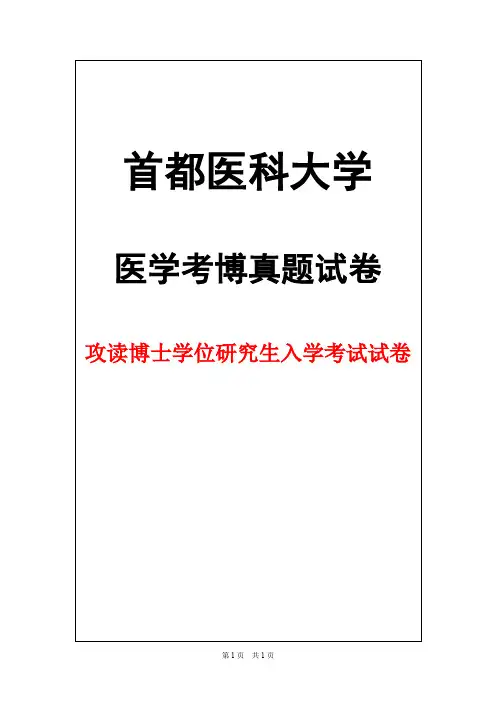
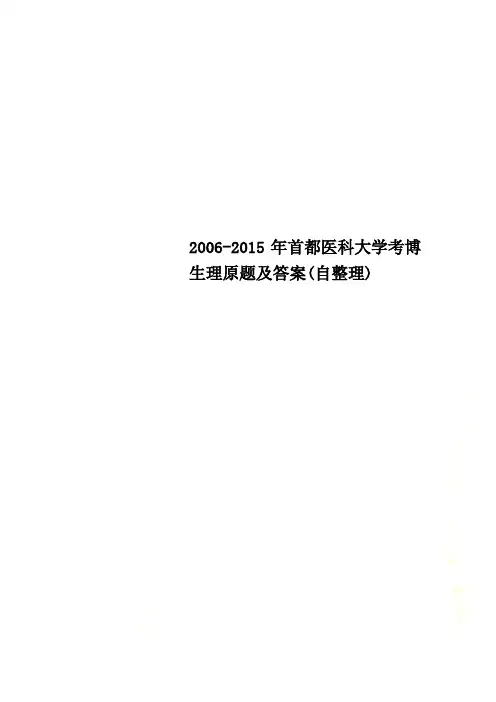
2006-2015年首都医科大学考博生理原题及答案(自整理)名词解释:1、all-or-none (2012)细胞产生动作电位的特点是,当刺激强度小于阈刺激时,细胞不产生动作电位,当刺激强度等于或大于阈强度时,细胞即产生动作电位,且幅度不再加大,此种现象称为“全或无”。
即动作电位的大小不随刺激强度的改变而改变。
2、recurrent inhibition (2012)是指某一中枢的神经元兴奋时,其传出冲动沿轴突外传,同时又经轴突侧支去兴奋另一抑制性中间神经元,该抑制性神经元兴奋后,其活动经轴突反过来作用于同一中枢的神经元,抑制原先发动兴奋的神经元及同一中枢的其他神经元。
3、overdrive suppression (2012)当自律细胞在受到高于其固有频率的刺激时,就按外加刺激的频率发生兴奋,称为超速驱动。
在外来的超速驱动停止后,自律细胞不能呈现其固有的自律性活动,需经一段静止期后才逐渐恢复其自律性,这种现象称为超速驱动压抑。
4、renal threshold for glucose (2012)尿中不出现葡萄糖的最高血糖浓度。
OR:近端小管对葡萄糖的吸收有一定限度。
当血糖浓度达180mg/100ml 时,有一部分肾小管对葡萄糖的吸收已达极限,尿中开始出现葡萄糖,此时的血浆葡萄糖浓度称为肾糖阈。
5、transducer function of receptor (2012)各种感受器在功能上的一个共同特点,是能把作用于它们的各种形式的刺激能量转换为传入神经的动作电位,这种能量转换称为感受器的换能作用。
6、basic electrical rhythm (2011,2010,2006)指胃肠平滑肌细胞在静息电位基础上产生缓慢的节律性的自动去极化波,又称慢波。
7、local potential (2011,2009,2007,2006)阈下刺激作用于细胞,引起膜原有的得到电位发生轻微的改变,称为局部电位。
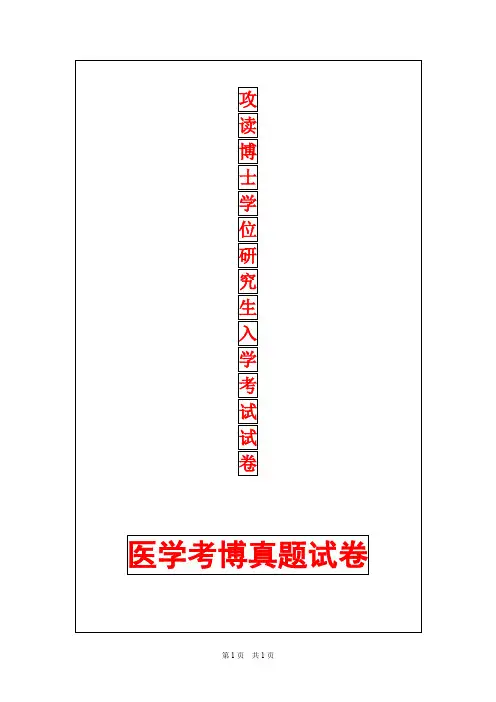
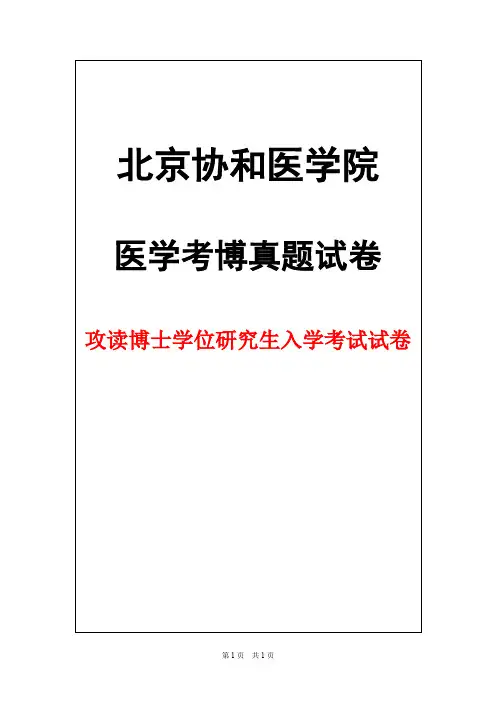
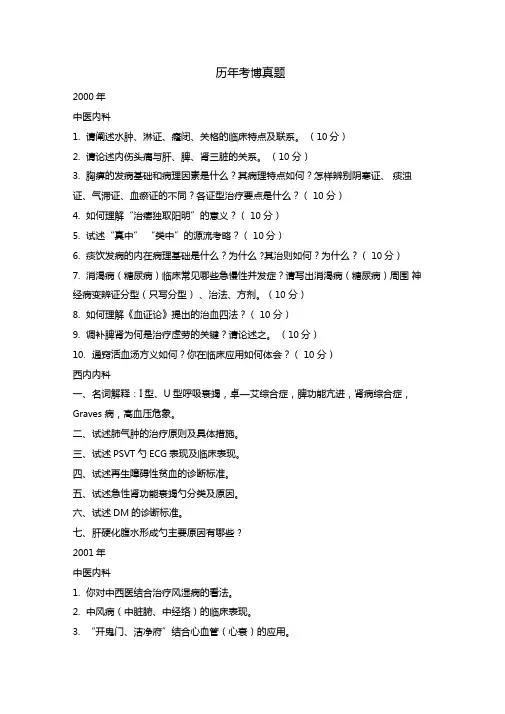

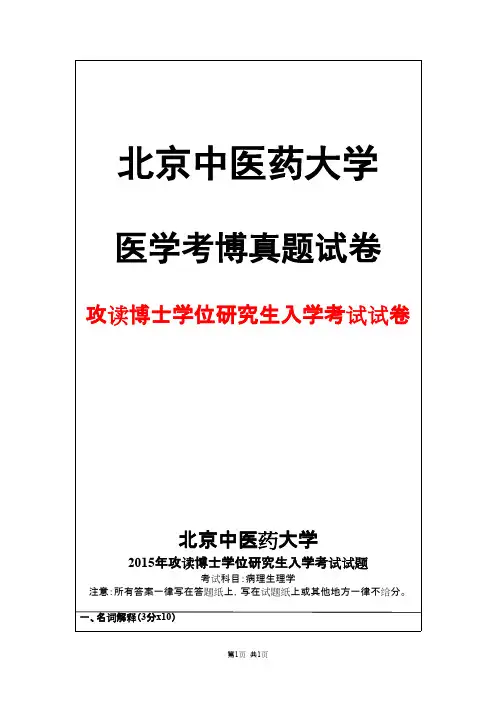
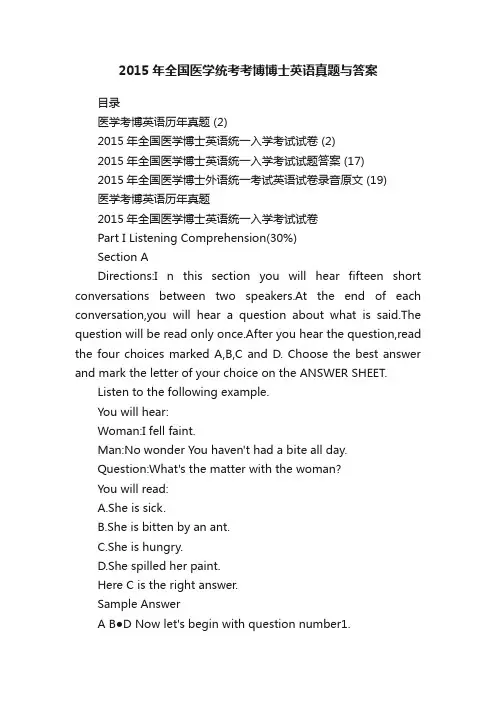
2015年全国医学统考考博博士英语真题与答案目录医学考博英语历年真题 (2)2015年全国医学博士英语统一入学考试试卷 (2)2015年全国医学博士英语统一入学考试试题答案 (17)2015年全国医学博士外语统一考试英语试卷录音原文 (19)医学考博英语历年真题2015年全国医学博士英语统一入学考试试卷Part I Listening Comprehension(30%)Section ADirections:I n this section you will hear fifteen short conversations between two speakers.At the end of each conversation,you will hear a question about what is said.The question will be read only once.After you hear the question,read the four choices marked A,B,C and D. Choose the best answer and mark the letter of your choice on the ANSWER SHEET.Listen to the following example.You will hear:Woman:I fell faint.Man:No wonder You haven't had a bite all day.Question:What's the matter with the woman?You will read:A.She is sick.B.She is bitten by an ant.C.She is hungry.D.She spilled her paint.Here C is the right answer.Sample AnswerA B●D Now let's begin with question number1.1. A.How to deal with his sleeping problem. B.The cause of his sleeping problem.C.What follows his insomnia.D.The severity of his medical problem.2. A.To take the medicine for a longer time. B.T o discontinue the medication.C.To come to see her again.D.To switch to other medications.3. A.To tale it easy and continue to work. B.To take a sick leave.C.To keep away from work.D.To have a follow-up.4. A.Fullness in the stomach. B.Occasional stomachache.C.Stomach distention.D.Frequent belches.5. A.extremely severe. B.Not very severe.C.More severe than expected.D.It's hard to say.6. A.He has lost some weight. B.He has gained a lot.C.He needs to exercise more.D.He is still overweight.7. A.She is giving the man an injection. B.She is listening to the man's heart.C.She is feeling the man's pulse.D.She is helping the man stop shivering.8. A.In the gym. B.In the office.C.In the clinic.D.In the boat.9. A.Diarrhea. B.Vomiting.C.Nausea.D.A cold.10. A.She has developed allergies. B.She doesn't know what allergies are.C.She doesn't have any allergies.D.She has allergies treated already.11. A.Listen to music. B.Read magazines.C.Go play tennis.D.Stay in the house.12. A.She isn't feeling well. B.She is under pressure.C.She doesn't like the weatherD.She is feeling relieved.13. A.Michael's wife was ill B.Michael's daughter was ill.C.Michael's daughter gave birth to twins.D.Michael was hospitalized for a check-up.14. A.She is absent-minded. B.She is in high spirits.C.She is indifferent.D.She is compassionate.15. A.Ten years ago. B.Five years ago.C.Fifteen years ago.D.Several weeks ago.Section BDirections:In this section you will hear one conversation and two passages'after each of which,you will hear five questions.After each question,read the four possible answers marked A,B,C and D.Choose the best answer and mark the letter of your choice on the ANSWER SHEET.Dialogue16. A.A blood test. B.A gastroscopy.C.A chest X-ray exam.D.A barium X-ray test.17. A.To lose some weight. B.To take a few more tests.C.To sleep on three pillows.D.To eat smaller,lighter meals.18. A.Potato chips. B.Chicken. C.Cereal. D.fish.19. A.Ulcer B.Cancer C.Depression. D.Hernia.20. A.He will try the diet the doctor recommended.B.He will ask for a sick leave and relax at home.C.He will take the medicine the doctor prescribed.D.He will take a few more tests to rule out cancer.Passage One21. A.A new concept of diabetes.B.The definition of Type1and Type2diabetes.C.The new management of diabetics in the hospital.D.The new development of non-perishable insulin pills.22. A.Because it vaporizes easily.B.Because it becomes overactive easily.C.Because it is usually in injection form.D.Because it is not stable above40degrees Fahrenheit.23. A.The diabetics can be cured without taking synthetic insulin any longer.B.The findings provide insight into how insulin works.C.Insulin can be more stable than it is now.D.Insulin can be produced naturally.24. A.It is stable at room temperature for several years.B.It is administered directly into the bloodstream。
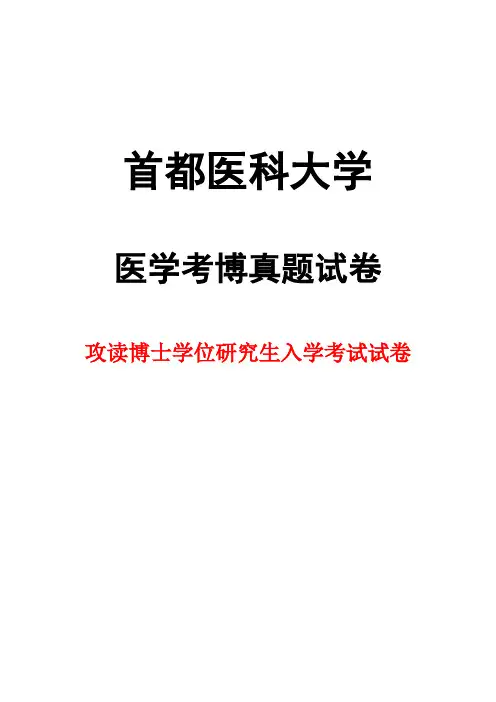

2015医学考博试题2015年中山大学肿瘤防治中心分子医学专业考博试题生物化学(一)六选五1.米氏方程式公式是什么?Km,Vmax的意义。
三种可逆性抑制剂存在情况下,Km,Vmax的变化。
2.如何进行克隆的构建以及质粒的扩增与抽提?3.衰老的细胞分子机制(至少五点并作解释)。
4.分子量20KD,PI=5.5的核蛋白的抽提。
5.蛋白质的翻译后修饰及生理作用,写出修饰的氨基酸。
6.可以进行分子标记三种酶,并比较底物和作用方式。
细胞生物学六选五1.应用抗原抗体反应的分子生物学技术(至少五种)2.比较细胞自噬,细胞凋亡,细胞坏死3.细胞骨架的组成及如何调控胞质分裂和核分裂4.细胞周期各时期的物质合成5.膜泡运输的方式及调控2015中山医肿瘤学考博真题必答题(15*4)1. 良恶性肿瘤的区别2. 肿瘤三级预防的定义和方法3. 简述第二信使4. P53基因异常表达的形式选答题(6选2 20*2)5. 肿瘤化疗用药的原则6. NHL和HL的区别(病理类型上,治疗方案上)7. 食管癌手术的注意事项8. 乳腺癌放疗原则9. 对不起忘啦10. 肿瘤干细胞的定义和特征11. 实验设计题,给出肿瘤转移可能相关基因,设计实验进行功能验证12. 细胞周期各期特点和关键check-point2015年浙大考博专业基础课--病理与病理生理学真题(回忆版)病理学部分一、名词解释(3*8):表观遗传学,细胞信号传导,DNA甲基化,凋亡,基因芯片,转录因子,异型性,癌前病变二、简答题(六选三,3*12):1.简述病毒与肿瘤的关系。
2.请简述肿瘤的分子分型。
3.目前结直肠癌发生的分子机制有几种,请你谈谈你的评价。
4.消化道常见的溃疡性病变有哪些(至少4种)及其病理学特点及鉴别要点。
5.肿瘤上皮间质转化(EMT)的概念,它与肿瘤存在哪些联系,谈谈你所了解的机制。
6.免疫组织化学技术的概念及其应用范围。
病理生理学部分(四选二,2*20)1.抑癌基因失活的机制有哪些?请举例说明其在肿瘤发生发展中的作用。
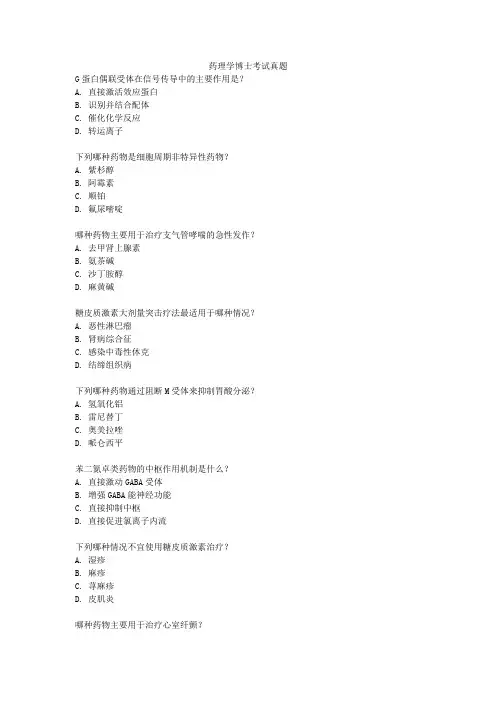
药理学博士考试真题G蛋白偶联受体在信号传导中的主要作用是?
A. 直接激活效应蛋白
B. 识别并结合配体
C. 催化化学反应
D. 转运离子
下列哪种药物是细胞周期非特异性药物?
A. 紫杉醇
B. 阿霉素
C. 顺铂
D. 氟尿嘧啶
哪种药物主要用于治疗支气管哮喘的急性发作?
A. 去甲肾上腺素
B. 氨茶碱
C. 沙丁胺醇
D. 麻黄碱
糖皮质激素大剂量突击疗法最适用于哪种情况?
A. 恶性淋巴瘤
B. 肾病综合征
C. 感染中毒性休克
D. 结缔组织病
下列哪种药物通过阻断M受体来抑制胃酸分泌?
A. 氢氧化铝
B. 雷尼替丁
C. 奥美拉唑
D. 哌仑西平
苯二氮卓类药物的中枢作用机制是什么?
A. 直接激动GABA受体
B. 增强GABA能神经功能
C. 直接抑制中枢
D. 直接促进氯离子内流
下列哪种情况不宜使用糖皮质激素治疗?
A. 湿疹
B. 麻疹
C. 荨麻疹
D. 皮肌炎
哪种药物主要用于治疗心室纤颤?
A. 奎尼丁
B. 维拉帕米
C. 利多卡因
D. 普萘洛尔。
2015年Passage oneThe American society of clinical oncology wrapped its annual conference this week, going through the usual motions of presenting a lot of drugs that offer some added quality or extension of life to those suffering from a variety of as-yet incurable diseases. But buried deep in an AP story are a couple of promising headlines that seems worthy of more thorough review, including one treatment study where 100 percent of patients saw their cancer diminish by half. 美国临床肿瘤协会于本周召开年会,大会讨论像往年一样提议了一些药物,能够提高疗效以及延长那些已确诊的不治之症患者的寿命,但深挖美联社报道中文章,发现一个有前景的标题,值得我们进一步了解,其中一个治疗研究,明确所有患者经过治疗后有一半患者肿瘤消失。
First of all, it seems pharmaceutical companies are moving away from the main cost-effective one-size-fits-all approach to drug development and embracing the long cancer treatments, engineering drugs that only work for a small percentage of patients but work very effectively within that group. 首先,制药公司从主要以效益一刀切发展模式向药物研发和接受长期癌症治疗,以及针对一小部分患者且成效显著的药物研发。
2004年山东大学药理试题(博士)一、翻译并解释(英文)1.G-蛋白耦联受体G protein-coupled receptor 是一类由GTP结合调节蛋白组成的受体超家族,可将配体带来的信号传送至效应蛋白,产生生物效应。
G蛋白的调节的效应器包括酶类,如AC、PLC等及某些离子通道2.摄取1Uptake-1也称神经摄取(neuroal uptake),是机体消除神经递质作用的一种方式,神经末梢依靠突触前膜上的特殊转运蛋白把释放的神经递质主动转运进入神经细胞内的机制,进入细胞内的递质可重新进入囊泡储存备用,或者被酶破坏。
比如去甲肾上腺素主要依赖这种方式失活。
(许多非神经组织如心肌、血管、肠道平滑肌也可摄取NA,这种摄取对NA的容量较大,但其亲和力远低于摄取-1。
且被摄取-2摄入组织的NA并不储存而是很快被酶破坏。
也称为非神经摄取)3.单胺氧化酶Mono-anine oxidase(MAO),使儿茶酚胺类神经递质失活的酶4.细胞周期非特异性药物细胞周期非特异性药物是指对处于细胞增殖周期中的各期(G1、S、G2、M)或是休止期的细胞(C0期)均具有杀灭作用的药物。
它们大多能与细胞中的DNA结合,阻断其复制,从而表现其杀伤细胞的作用。
抗肿瘤药物中的烷化剂及阿霉素、博莱霉素等即属于此类药物。
5.孤儿受体属于核受体家族,大多根据基因组测序发现的一类结构与甾体激素受体类似的蛋白表达产物,但是到目前为止尚未发现这些蛋白表达产物与某种激素结合,即尚未发现其配体。
因此把它们称为孤儿受体或孤儿核受体6.细胞色素P450细胞色素P450(cytochrome,CYP450)是一类以还原态与CO结合后在450nm处具有最高吸收峰的含血红素的单链蛋白质。
它参与内源性物质和包括药物、环境化合物在内的外源性物质的代谢。
7.受体上调Receptor up-regulation,某种受体激动剂水平降低或长期应用拮抗药造成组织或细胞上表达的该种受体的数量增加的现象,称为受体上调8.折返激动折返激动是所有的快速性心律失常最常见的发生机制。
完整word版首医考博试题Word版首医考博试题一、单选题1. 下列哪项为氨基酸中的无极性疏水氨基酸?A. 谷氨酸B. 赖氨酸C. 苏氨酸D. 番氨酸2. 以下哪个器官是人体最大的内分泌腺?A. 甲状腺B. 肾上腺C. 胰腺D. 垂体3. 下列哪种物质可以通过胎盘屏障进入胎儿循环系统?A. 红细胞B. 白细胞C. 蛋白质D. 脂肪酸4. 高浓度的胆汁会导致下列哪种胆结石最易形成?A. 胆盐结石B. 胆固醇结石C. 黑色素结石D. 铁结石5. 下列哪种白细胞在炎症反应中首先出现?A. 嗜好性粒细胞B. 巨噬细胞C. 嗜酸性粒细胞D. 中性粒细胞二、多选题1. 下列哪些物质能穿过血脑屏障?A. 葡萄糖B. 氯化钠C. 氨基酸D. 氯化铵2. 下列哪些形成过程中与凝血无关?A. 纵隔静脉血栓形成B. 动脉粥样硬化斑块形成C. 静脉曲张形成D. 血小板聚集形成血栓3. 以下哪些细胞可以分泌胃酸?A. 表皮细胞B. 刺激细胞C. 壁细胞D. G细胞4. 下列哪些是调节体温的主要因素?A. 室内温度B. 外界温度C. 代谢热D. 神经调节5. 以下哪些物质由肾脏排泄?A. 毒物B. 代谢产物C. 水分D. 药物三、判断题1. 生活垃圾属于医疗废物。
()2. 人体的胆固醇主要通过肝脏代谢清除。
()3. 淋巴系统的主要功能是输送乳汁。
()4. 低钠血症可导致细胞溶解。
()5. 静脉曲张是静脉瓣功能障碍导致的。
()四、简答题1. 请解释生物体的稳态。
生物体的稳态是指在变化的外界条件下,通过内部调节机制使得生物体的内部环境保持相对稳定的状态。
这种稳态使得生物体能够适应外界环境的变化,并保持其正常生理功能的进行。
2. 请解释血液凝固过程中的内外路线。
血液凝固过程中的内外路线是指在不同的刺激下,血液凝结的两条途径。
内路线是由血液内部因子直接参与的凝血过程,外路线是由血管损伤刺激引起的凝血过程。
3. 请解释代谢性酸中毒和呼吸性酸中毒的区别。